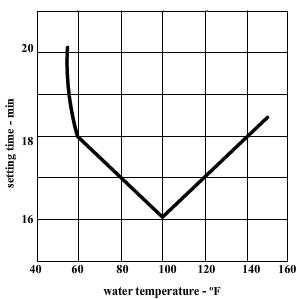Water temperature is considered to be a factor that determines the characteristics of the plaster mix. This takes place owing to its ability to influence both solubility of the material and the rate of crystallization: water solubility of CaSO4.2H2O is moderate and shows direct relation to the temperature until a certain point; then the retrograde solubility takes place, which means that when the temperature increases, the material becomes less soluble. The corresponding influence on setting time is shown at Figure 1 (Plaster Fundamentals):

The segment between 80 and 100ºF shows the maximum of plaster solubility, and then the slump takes place.
The results of the experiment have approved the expected effect of water temperature upon plaster’s parameters:
Setting Time: According to the theoretical background, the temperature increase may decrease the setting; however, not necessarily. The sample which implied using chilled water has shown the latest initial (1.71 times longer that the sample with no additive (1), and effect of retardation) and final set (equal to the sample with no additive (1)). Warm water made the process more accelerated comparing to that chilled; however, the values of initial and final set are much bigger than those which took place in cases with other additives. Comparing to the sample with no additive (1), the initial set is 1.29 times longer, and the final set is only 0,786 (effect of acceleration).
Flexural strength: A sample which implied using warm water showed flexural strength 2.98 Mpa, chilled water 1.80 Mpa. Thus, their ratios to the value of the sample with no additive (1) are 0.351 and 0.582 correspondingly. When analyzing the samples’ flexural strength in detail, it is reasonable to consider a difference in the samples’ dimensions: 0.08/0.034/0.015 for the warm water sample, and 0.08/,0.35/0.018 for that of cold water, which means that the ratio of (from the flexural strength formula) is 10457.52 and 7054.674 correspondingly; their ration is 1.482, while the flexural strength values ratio for is 1.657 for these two samples; the rest difference is related to the difference in weight used in the experiment (19 and 17 kg correspondingly).

Thus, using different water temperature has shown its effect on the characteristics of plaster; however, this effect is slighter than that shown by other additives.
Reference
Plaster Fundamentals. (n.d.). PlasterMaster. 2010. Web.